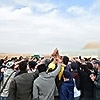Audio Version Of The Blog – 11/19/23
Listen to an Audio Version of the Blog
Download:MP3 Audio

Listen to an Audio Version of the Blog
Download:MP3 Audio

Michael Laitman on the Times of Israel: “On MIT Predicting Society’s Collapse in 2040”
The civilization we should aim for is one that could prevent the predicted collapse, and it is built on universal love, interconnection and mutual assistance. However, achieving such a state in human society requires acknowledging the flaws in our current civilization, that we relate to each other with an egoistic and divisive mindset instead of upgrading our relations to positively connect above our egos. Our challenge lies in exposing these flaws in our present way of life.
We must recognize the flaws of our egoistic attitudes in an increasingly interdependent world in either a positive or negative manner: either through blows of suffering that will eventually lead us to a positive state, or by revealing a path that will let us progress to a better world without having to experience the blows.
Given the current state of humanity’s competitive, materialistic and individualistic way of life, it appears that we will have to develop through suffering. It now seems unlikely that humanity can recognize or understand this. Each person must first acknowledge the flaws in their inherent egoistic nature, and we can then begin a correction process where we each focus on self-transformation rather than trying to correct others.
Ideally, we hope to avoid significant blows, but the overall trend suggests otherwise. Our current path prioritizes individual success at the expense of others, leading to exploitation, manipulation and abuse of all kinds. This trajectory should make us realize that we are enemies of each other, and likewise, we are also enemies of ourselves. The true enemy is not external but resides within. It is crucial to bring humanity to this realization as soon as possible.
Self-transformation and self-correction are necessary for a future where love and goodness triumph over evil. In a world filled with relations of love and mutual care, people will abandon unnecessary work, enjoy leisure activities and care for their families. They will find joy in simple pleasures like walks in the park, listening to birds singing and relating positively to each other, being able to stop, greet and talk pleasantly at length with anyone. This vision, while some might find it ideal, can also be considered naive. In reality, we understand our lives as involving struggles over resources, territory and the like. But if we accept the direction to a civilization guided by principles of love and mutual consideration, then we will find plenty of struggles in the fact that we try to create and achieve a harmonious outcome together.
In a civilization with love and positive connection as its leading principles, the struggle will shift toward how to demonstrate more and more love for others. This will indeed be challenging. We can expect myriad dramas alongside joy and love. Dramas are an integral part of life, but ultimately, we will strive for mutual love and positive connection as our primary goal. We will then feel ourselves moving closer and closer to such a goal the more we value others over ourselves, and despite the challenges, we will experience a life of harmony, peace and happiness increasingly widen ahead of us.
[320874]
 Question: Usually, children under the age of five play without relating to each other in any way. Humanity is going through the same state now as we do not seem to be in contact with each other.
Question: Usually, children under the age of five play without relating to each other in any way. Humanity is going through the same state now as we do not seem to be in contact with each other.
Do we have to go through this state at an accelerated pace or do we have to go through everything we are supposed to without hurrying anywhere?
Answer: We have already passed the state of infancy because we have received instructions for correcting ourselves in connection with each other. That is why we all have to think only how to be connected by good intentions. That is what we ask in prayer.
Question: Then is a real prayer for all of humanity born?
Answer: For the Creator so that we provide Him with a vessel that He would fill with His love.
[320280]
From the Daily Kabbalah Lesson 11/3/23, Writings of Baal HaSulam “Concerning the Giving of the Torah – 2“
Related Material:
Humanity’s Development under the Influence of Spiritual Energy
How Does The World Feel The Approach Of The Creator?
Learning To Be An Adult
 Question: The more effort I put into connection, the further away from it I am and the more hatred there is in my heart, literally a wall. Is the Creator’s answer to me the fact that He gives me the strength to act like a soldier—just do it and that is it? Or should I somehow get to the feeling of unity?
Question: The more effort I put into connection, the further away from it I am and the more hatred there is in my heart, literally a wall. Is the Creator’s answer to me the fact that He gives me the strength to act like a soldier—just do it and that is it? Or should I somehow get to the feeling of unity?
Answer: I do not know how much you will be able to get to the truth, but at least try with all your heart and with all your strength to aim for the Creator.
Question: What if I still want to get to the bottom of it?
Answer: Then you have to dig all over yourself. You must purify every feeling and every thought from egoism, and direct it to the Creator.
[320196]
From the 1st paer of the Daily Kabbalah Lesson 11/2/23, Writings of Rabash “What Is the Son of the Beloved and the Son of the Hated in the Work?”
Related Material:
Turn Only to the Creator
On Any Occasion—Turn To The Creator
Going With Faith Above Reason
 The thought of creation, called “to do good to His creations,” begins from Ein Sof [no end]. For this reason, we pray to Ein Sof, meaning to the connection that exists between the Creator and the creatures.
The thought of creation, called “to do good to His creations,” begins from Ein Sof [no end]. For this reason, we pray to Ein Sof, meaning to the connection that exists between the Creator and the creatures.
The beginning of the connection starts in Ein Sof, where His name is, which is the root of creation (Baal HaSulam, Shamati 54 “The Purpose of the Work – 1“).
Question: Ein Sof is something that we cannot attain, i.e., equivalence of form. What is this quality of His name and what does it mean to pray to His name?
Answer: His name is the result of attainment from below. When the light of the Creator enters our Kli, then we begin to feel His name.
When we are directed to the fact that the Creator is upper, He is the first, He is the Creator, He is good and does good, and there is none else besides Him, it turns out that we are directed only to the upper root.
Question: How do we pray to Ein Sof correctly? How does one direct oneself to it?
Answer: We are able to feel this only through love for our neighbor, otherwise it is impossible.
[320336]
From the Daily Kabbalah Lesson 11/5/23, Writings of Baal HaSulam “The Purpose of the Work – 1“
Related Material:
Veils of Perfection
Creation’s Worst Nightmare
From Love To Hatred And Back To Love
 Question: If I see myself as evil in the outside world, but at the same time I feel love in the ten, where and what am I distorting?
Question: If I see myself as evil in the outside world, but at the same time I feel love in the ten, where and what am I distorting?
Answer: You must make sure that in the outside world you are also perceived as exuding love. You must have that feeling about the whole world, even your enemies.
Comment: It is very difficult.
My Response: That is good. And now try to create a relationship of love over your rejection.
It is necessary to refresh the atmosphere. Do not be ashamed to tell each other about love, simply admit it even though it may not be 100% true that we love each other.
Comment: But there must be an inner prayer.
My Response: That is when you will feel what prayer means.
I see that lately we have gradually begun to go through such internal states that will help us to get closer between us and the Creator. I am very proud of you.
[320320]
From the Daily Kabbalah Lesson 11/4/23, Writings of Baal HaSulam “First Will Be the Correction of the World“
Related Material:
To a World of Love
Bring Your Hatred To The Light
Don’t Let The Source Dry Up
 Question: How when I am in a ten can I come to despair and cry to the Creator?
Question: How when I am in a ten can I come to despair and cry to the Creator?
Answer: If you are in the ten, try to be connected with it into one common whole, and you have the task ahead of you to reach the Creator, then you begin to see how impossible this task is for you and your ten. That is when you start crying to the Creator.
Question: Am I crying or should the ten cry?
Answer: You, first of all.
Question: Does it then turn out that I am disappointed in the ten?
Answer: No. You see that you are placing yourself above the ten, and you cannot agree with this.
[320199]
From the 1st part of the Daily Kabbalah Lesson 11/2/23, Writings of Rabash “What Is the Son of the Beloved and the Son of the Hated in the Work?”
Related Material:
Demand the Creator’s Intervention
Pray And Ask!
Contact The Creator
 Question: What is the difference between the revelation of the Creator to a person, when we see the Creator behind each friend, and the fact that we look at the holy Shechina?
Question: What is the difference between the revelation of the Creator to a person, when we see the Creator behind each friend, and the fact that we look at the holy Shechina?
Answer: The difference is that if we want to get closer to the Creator, to His qualities, the quality of bestowal, connection, and love, then we cannot think about anything else. We must put everything on the rails, except what is necessary.
Necessities include caring for children and so on. And all the most important things we have in our souls should be directed to the Creator and connected with Him.
Question: What is the difference between directing yourself to the Creator or directing yourself to the observation of the Shechina?
Answer: Directing yourself to the Creator means to be only on the path to this. But seeing the Shechina or connecting with it is already reaching complete connection with the Creator.
Question: But the connection of the souls of Israel is the Shechina. Is this what we are yearning for? When we say that we want to unite, it is as if we want to see the Shechina between us.
Answer: Yes, of course. But that is the goal. This is not yet the desire we should be in.
Question: Then what should be the desire if the ultimate goal is to connect to Shechina for the sake of the Creator. Where is the Creator?
Answer: The Creator is reached through the connection between us, when we prefer to be connected with Him and with nothing else. This is the path to the Creator.
[320192]
From the Daily Kabbalah Lesson 11/1/23, “Depart from Evil”
Related Material:
The Greatness of the Shechina
Ready to Raise the Shechina from the Dust
Become A Spiritual Partzuf
 Question: What is a Partzuf?
Question: What is a Partzuf?
Answer: A Partzuf is a spiritual object that receives light for the sake of giving to the Creator and consists of three parts: Rosh, Toch, and Sof (head, trunk, and legs).
The head (Rosh) performs the function of receiving the upper light, feeling it, and figuring out how to work with it in order to receive it for the sake of bestowal, in the likeness of light. After that, the enjoyment of light passes from the head into the body (Toch) of the Partzuf and is felt there.
What the Partzuf cannot accept into the body is blocked by it for receiving, and empty desires remain from the waist and below (Sof), which cannot be filled for the sake of the Creator’s pleasure.
Question: In principle, we are talking about desires. Is the Partzuf a desire that is in every person, or is it a common desire of all mankind?
Answer: Both this and that. In general, we all represent the whole of humanity as one Partzuf. On the other hand, each of us and each part of us is also divided into Partzufim.
Just like in our world, if I see some type of pleasure, I automatically scroll through options in my head on how to optimally enjoy it. As I accept it, I feel this pleasure in myself. And there is still some part that I cannot accept for some reason. It is only in the spiritual that all pleasures are determined in relation to the Creator.
[318776]
From KabTV’s “Preface to the Wisdom of Kabbalah” 9/26/23
Related Material:
Become A Spiritual Partzuf
A Workshop Is The Creation Of A “Spiritual Partzuf”
Building Among Us A “Spiritual Partzuf”
Preparation to the Lesson
1st part of the Lesson — Writings of Rabash, “Who Needs to Know that a Person Withstood the Test”
2nd part of the Lesson — Writings of Baal HaSulam, “Study of the Ten Sefirot,” Vol. 2, Part 6, Item 4
3rd part of the Lesson — Writings of Baal HaSulam, “A Speech for the Completion of The Zohar“
Selected Highlights